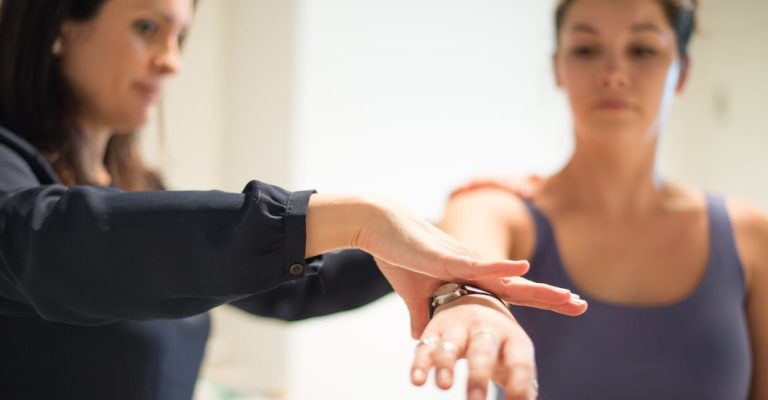
Even while dealing with flexion synergy patterns after a stroke may be quite unpleasant, the fact that they indicate that recovery is progressing at all is very positive.
Movements that are synergistic are those that occur from many muscle contractions being stimulated at the same time. When you attempt to move your shoulder, for instance, you can feel a contraction in your elbow.
The occurrence of flexion synergy patterns is a phenomenon that is often seen in people who have suffered from a stroke. These patterns describe the manner in which certain muscle groups in the body “synergize” with one another in order to create movement in the limb that is being impacted. When it comes to assisting stroke patients on their road to recovery, having a solid understanding of flexion synergy patterns might be of critical importance.
The term “synergy patterns” refers to the manner in which several muscle groups in the body create movement by cooperating with one another, also known as “synergizing.” They are distinguished from the isolated activity of individual muscle groups by the coordinated action of many muscle groups rather than by the activity of individual muscle groups acting alone. To put it another way, when a synergy pattern is present, several muscles collaborate in order to carry out a certain action, as opposed to each muscle acting separately to carry out the movement.
Synergy patterns are not exclusive to people who have had a stroke; they may also be seen in healthy persons. This is because the body naturally employs particular muscle groups to produce certain motions in cooperation with other groups of muscles.
However, in some instances, such as after a stroke or another neurological condition, the brain’s ability to control individual muscle groups may be impaired, which can lead to the development of abnormal or compensatory synergy patterns. These patterns can be caused by the brain trying to adapt to its new state.
It is possible to have several kinds of synergy patterns, such as flexion synergy patterns (which were explained before), extension synergy patterns, and other kinds of synergy patterns, depending on the particular muscle groups that are cooperating with one another.

Three motions are involved in flexion synergy patterns following stroke:
In other words, whenever you move your afflicted arm, your shoulder raises, your elbow contracts, and your wrist turns till your palm faces up. This may occur even if you do not initiate movement, such as when you cough or sneeze.
While these movements might be bothersome, they are also an indication that you are making progress in your stroke recovery.
Flexion synergy patterns arise in Brunnstrom stages 2 and 3 of stroke recovery.
The muscles are flaccid during the initial Brunnstrom stage. This implies that signals from your brain are not reaching your muscles, causing them to become momentarily paralyzed.
However, as you go through phases 2 and 3, the brain begins to re-establish a link with the muscles, and the muscles begin to “wake up.” That is when patterns of synergy might arise.
Flexion synergy patterns are your brain’s approach to reinforcing muscular control. This is a lengthy process, but it is feasible to speed it up.
Most therapists would agree that doing rehab activities poorly (i.e., with synergistic movement patterns) is not desirable since it may perpetuate these bad movement patterns.
When severe spasticity and synergistic movement prohibit a stroke survivor from moving at all, it’s evident that any sort of movement is preferable to none when you’re giving it your all and concentrating on the correct form every time.
As long as you do your hardest to employ proper form every time you exercise, you will continue to promote neuroplasticity and improve.
The more you exercise your injured muscles, the more your brain can generate new neural connections that will allow muscle groups to communicate again.
Of course, this may be difficult, particularly when motions are abnormal. As a result, working with a physical therapist to identify the optimal solution is your best bet.
As you continue to exercise, you should ultimately be able to attain normal mobility and function — or as near to it as feasible.
Here are some exercises that help you overcome flexion synergy patterns:
Passive range-of-motion exercises may help you retain your range of motion and may aid in restoring muscular control. The therapist works your muscles for you during passive exercises.
Even if you aren’t physically moving it, having someone else do it is enough to excite the brain and reignite the neural networks that let you move.

Sensory stimulation is critical in synergistic movements. It is what tells your muscles how and where to move.
Proprioceptive receptors in muscles assist the brain in determining where your joints are in space. This allows the brain to choose which muscles to engage in order to move.
Sensation might be affected after a stroke. Sensory exercises aid in the restoration of your senses and, as a result, the improvement of your mobility.
Active range of motion exercises aid in the improvement of joint function. Range of motion refers to how far your joints can move in various directions. These exercises assist you in moving each joint through its whole range of motion. Movement may assist in maintaining joint flexibility, alleviate discomfort, and increase balance and strength.
Again, you will most likely be unable to do these actions perfectly when you first begin. That’s great; just do your best and keep practicing.
Flexion synergy patterns allow you to move many segments of your arm at the same time. They are unpleasant, but they are a sign that your brain and muscles are communicating better.
Fortunately, flexion synergy tendencies may be addressed with the persistent use of therapeutic rehab activities. These exercises serve to retrain the brain and isolate the appropriate muscle group.
You may restore voluntary control of your muscles and move your arm smoothly again with enough practice.